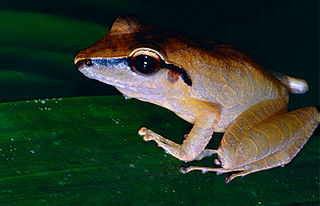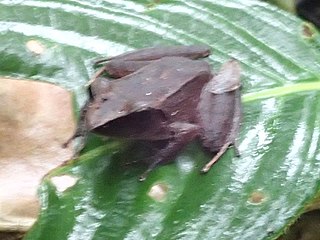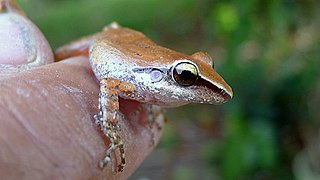Pristimantis actites is a species of frog in the family Strabomantidae. It is endemic to Ecuador. Its natural habitats are tropical dry forests, moist montane forests, rural gardens, and heavily degraded former forest. It is threatened by habitat loss.
Pristimantis baryecuus is a species of frog in the family Strabomantidae. It is endemic to Ecuador. Its natural habitats are tropical moist montane forests, high-altitude shrubland, and heavily degraded former forest. It is threatened by habitat loss.
Pristimantis chalceus is a species of frog in the family Strabomantidae. It is found in Colombia and Ecuador. Its natural habitats are tropical moist lowland forests, moist montane forests, rivers, and heavily degraded former forest. It is threatened by habitat loss.

Pristimantis chiastonotus is a species of frog in the family Strabomantidae. It is found in Brazil, French Guiana, Suriname, and possibly Guyana. Its natural habitats are tropical moist lowland forests, rural gardens, and heavily degraded former forest. It is threatened by habitat loss.

Pristimantis conspicillatus is a species of frog in the family Strabomantidae. It is found in Brazil, Colombia, Ecuador, and Peru. Its natural habitat is tropical moist lowland forests.
Pristimantis cremnobates is a species of frog in the family Strabomantidae. It is endemic to Ecuador. Its natural habitats are tropical moist montane forests and rivers. It is threatened by habitat loss.
Pristimantis devillei is a species of frog in the family Strabomantidae. It is endemic to Ecuador. Its natural habitats are tropical moist montane forests, high-altitude shrubland, and tundra. It is threatened by habitat loss.
Pristimantis dissimulatus is a species of frogs in the family Strabomantidae.
Pristimantis floridus is a species of frog in the family Strabomantidae.
Pristimantis ganonotus is a species of frog in the family Strabomantidae. It is endemic to Ecuador. Its natural habitats are tropical moist montane forest and heavily degraded former forest. It is threatened by habitat loss.
Pristimantis glandulosus is a species of frog in the family Strabomantidae. It is endemic to Ecuador. Its natural habitats are tropical moist montane forests and high-altitude grassland. It is threatened by habitat loss.
Pristimantis hamiotae is a species of frog in the family Strabomantidae. It is endemic to Ecuador. Its natural habitats are tropical moist montane forests and rocky areas. It is threatened by habitat loss.
Pristimantis labiosus is a species of frog in the family Strabomantidae. It is found in Colombia and Ecuador. Its natural habitats are tropical moist lowland forests, moist montane forests, and rivers. It is threatened by habitat loss.

Pristimantis lanthanites is a species of frog in the family Strabomantidae. It is found in Brazil, Colombia, Ecuador, and Peru. Its natural habitats are tropical moist lowland forests and moist montane forests.
Pristimantis latidiscus is a species of frog in the family Strabomantidae. It is found in Colombia, Ecuador, and possibly Panama. Its natural habitats are tropical moist lowland forests and moist montane forests. It is threatened by habitat loss.

Pristimantis martiae is a species of frog in the family Strabomantidae. It is found in Brazil, Colombia, Ecuador, Peru, and possibly Bolivia. Its natural habitats are tropical moist lowland forests and moist montane forests.

Pristimantis ornatissimus is a species of frog in the family Craugastoridae. It is endemic to Ecuador. Its natural habitats are tropical moist lowland forests and moist montane forests, at altitudes of 400–1800 meters. It is threatened by habitat loss.

Pristimantis paulodutrai is a frog species in the family Craugastoridae; it was formerly placed in the "wastebin genus" Eleutherodactylus. It is sometimes known by common name Paulo's robber frog. It is endemic to the Atlantic forest of eastern Brazil, from southern Bahia north to Alagoas.
Pristimantis peruvianus is a species of frog in the family Craugastoridae. It is found in the upper Amazon Basin in western Brazil, southern Ecuador, eastern Peru, and southeast Colombia. Records from Bolivia likely refer to an undescribed species, although it is possible that also the "true" Pristimantis peruvianus is to be found there. Its natural habitats are upland cloud forests, flooded lowland forests, and oxbow palm swamp forests. It is a common species.
Pristimantis walkeri is a species of frog in the family Craugastoridae. It is endemic to Ecuador. Its natural habitats are tropical dry forests, moist lowland forests, moist montane forests, plantations, rural gardens, and heavily degraded former forest. It is threatened by habitat loss.







